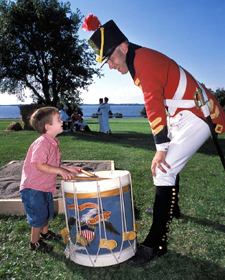Sackets Harbor Battlefield State Historic Site

504 W. Main Street
Sackets Harbor, NY 13685

Pavilion Information
Sackets Harbor Battlefield has one pavilion. The day use price is $60 and can accommodate up to 60 people. Check availability at ReserveAmerica.com.
P.O. Box 27 Sackets Harbor, NY 13685
Hours of Operation
Grounds:
Open year-round, closed at dark
Facilities:Museum Shop, gallery, navy yard buildings, barn and Hall House exhibits open Saturdays through October 11 - 10am to 4:30pm
Guided tours of the Commandant's House available on Saturdays at the top of each hour.
Available for adult groups and school tours by appointment.
Fees & Rates
Most New York State Parks charge a vehicle use fee to enter the facility. Fees vary by location and season. A list of entry fees and other park use fees is available below. For fees not listed or to verify information, please contact the park directly.
The easy-to-use Empire Pass card is $80- and your key to all-season enjoyment with unlimited day-use entry at most facilities operated by State Parks and the State Dept. of Environmental Conservation including forests, beaches, trails and more. Purchase online or contact your favorite park for more information. Learn more about our Admission Programs including the Empire Pass.
- Picnic Area
- No Charge
- Tour Fees
- Adult $5
Senior/Student $3Free admission ages 12 years and younger
Fee Collection 10AM to 5PM
The Sackets Harbor Battlefield State Historic Site annually offers the late spring "War of 1812 in Sackets Harbor" curriculum based immersive field trip program for elementary school students includes a craft, scavenger hunt, period toys and games, and demonstration by War of 1812 living history presenters. Call for details.
Following the outbreak of war between the United States and Great Britain in June 1812, Sackets Harbor became the center of American naval and military activity for the upper St. Lawrence Valley and Lake Ontario. The brig Oneida, with a company of marines, was already at the harbor to suppress smuggling between northern New York and Canada. Local woodlands provided ample timber, and a large fleet was constructed at the harbor's extensive shipyard. Barracks were also built for the thousands of soldiers, sailors, and mechanics who soon arrived to provide the manpower for the invasion and conquest of Canada.
In an attempt to destroy the American shipyard, a British-Canadian force launched an attack on May 29, 1813. At that time the majority of the American forces were across Lake Ontario attacking Fort George. The remaining Americans drove off the enemy, but their narrow victory was marred by a fire that destroyed their military stores. During the remainder of the war, Sackets Harbor was an active station where naval ships were constructed and supplied. In December 1814, the Treaty of Ghent officially ended the War of 1812, and the Lake Ontario fleet was placed in storage at Shiphouse Point.
After the war, the massive earthen fortifications protecting the harbor were graded off and the battlefield reverted to farmland. Several blockhouses were converted to barns and another became an office for the commandant of the Navy Yard.
The shipyard remained under Navy control because of the presence of an unfinished first-rate ship-of-the-line, the New Orleans. It was designed to carry a crew of 900 and was enclosed in a huge wooden ship house to protect it for future use. In 1817, the Rush-Bagot Agreement between the United States and Great Britain limited all naval forces on the Great Lakes. During the 1840s, old naval buildings were removed and new quarters were constructed for the naval commandant and sailing master (lieutenant), to meet the needs of a continuing naval presence.
The navy decided to scrap the New Orleans in 1883. The demolition of the vessel, together with improved Canadian-American relations, ended the need for a naval base in Sackets Harbor. The navy maintained the facility until 1955, although it was seldom used except for training by the state's naval militia.
The 1913 Centennial Park portion of the battlefield was recognized as early as 1866 as a special plot of land to be set aside to honor all the military personnel who had fought and died in the War of 1812. In 1878 the land was called the Old Battle Ground and was used for patriotic meetings, political rallies, church picnics, and other events.
New York State took control of the Navy Yard in 1967 and began acquiring more of the historic battlegrounds, including the most recent forty acres in 2006.

African American History Month
Across this nation and throughout the Empire State, African Americans have helped to shape American history, fight for independence, and secure freedom. The efforts of these individuals stand as a testament to their courage and an inspiration to us all.
In observance of African American History Month, the New York State Office of Parks, Recreation and Historic Preservation gives special recognition to some of the many stories associated with the African American experience at state historic sites.
At Sackets Harbor Battlefield, there is a unique connection between African American history and maritime history. African Americans made up nearly 15% of the U.S. Navy during the War of 1812, which took place mainly in waterways and port sites. The sea was not a place of full equality, but it was a place of far greater tolerance. Many African Americans found a level of freedom at sea that was unavailable on land.
Saturday, October 11, 2025 10:00 AM - 01:00 PM
Sackets Harbor Battlefield State Historic Site
Amenities Information
- Amenities
- Costumed Interpreters * Interpreters in reproduction period clothing
- Demonstrations
- Gift Shop (Accessible)
- Picnic Area (Accessible)
- Tours
- Visitor Center (Accessible)
